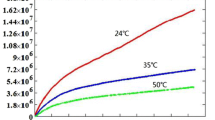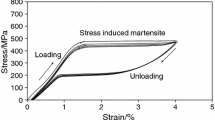Abstract
Objectives: Glass fiber reinforced shape memory polyurethane (GFRSMPU) has great potential to be an alternative kind of material for orthodontic archwires for overcoming the disadvantages of metal wires in terms of esthetic and allergy and deficiency of pure shape memory polyurethane (SMPU) wires in mechanical properties. The objective of this study was to investigate the thermo-mechanical properties and shape recovery functions of GFRSMPU and evaluate the feasibility of using this composite for orthodontic archwires. Material and methods: GFRSMPU were made from short cut glass fibers and SMPU by mixing extrusion. Scanning electron microscope (SEM) and differential scanning calorimetry (DSC) were performed to investigate the distribution of glass fibers in the mixture and glass transition temperature (Tg). Then the thermo-mechanical properties, including tensile modulus, flexural modulus and stress relaxation effects, were measured. Furthermore, shape recovery functions of GFRSMPU characterized by the shape recovery ratio and force were investigated through shape recovery tests, typodont models and finite element analysis (FEA). Results: SEM images indicated that an excellent dispersity of glass fibers was obtained after double-extrusion. DSC experiments showed Tg was not enormously affected with the existence of glass fibers, but the mechanical properties of GFRSMPU were greatly improved. Shape recovery tests showed reduction of shape recovery ratio of the GFRSMPU material with the addition of glass fibers, but dentition aligning time was reduced by 50% in the simulation performed on identical typodont models with GFRSMPU archwires filled with 30 wt.% glass fibers. The FEA results illustrated that the reacting forces of GFRSMPU archwires with 30 wt.% glass fiber was increased by 96.36% compared with pure SMPU archwires. Conclusions: The mechanical properties of GFRSMPU can be considerably improved by adding glass fibers, and the shape memory function would be well preserved too. Enhanced SMPU owns a good application prospect in orthodontics for dentation aligning on the preliminary stage, as well as other medical fields.










Similar content being viewed by others
References
Bos S, Hoogstraten J, Prahl-Andersen B. Expectations of treatment and satisfaction with dentofacial appearance in orthodontic patients. Am J Orthod Dentofac. 2003;123:127–32.
Liu YF, Wu JL, Zhang JX, Peng W. Feasible evaluation of the thermo-mechanical properties of shape memory polyurethane for orthodontic archwire. J Med Biol Eng. 2017;37:666–74.
Zhang H, Guo S, Wang D, Zhou T, Wang L, Ma J. Effects of nanostructured, diamondlike, carbon coating and nitrocarburizing on the frictional properties and biocompatibility of orthodontic stainless steel wires. Angle Orthod. 2016;86:782–8.
oli M, Tomić S, Rudolf R, Marković E, Scepan I. Differences in cytocompatibility, dynamics of the oxide layers’ formation, and nickel release between superelastic and thermo-activated nickel–titanium archwires. J Mater Sci Mater M. 2016;27:128–40.
Obaisi NA, Galang-Boquiren MTS, Evans CA, Tzong GP, Viana G, Berzins D, et al. Comparison of the transformation temperatures of heat-activated nickel-titanium orthodontic archwires by two different techniques. Dent Mater. 2016;32:879–88.
Giuliana L, Roberto DS, Antonio G, Teresa R, David SQ, Alberto L, et al. Calorimetric and thermomechanical properties of titanium-based orthodontic wires: DSC-DMA relationship to predict the elastic modulus. J Biomater Appl. 2012;26:829–44.
Lombardo L, Toni G, Stefanoni F, Mollica F, Guarneri MP, Siciliani G. The effect of temperature on the mechanical behavior of nickel-titanium orthodontic initial archwires. Angle Orthod. 2012;83:298–305.
Perrey W, Konermann A, Keilig L, Reimann S, Jager A, Bourauel C. Effect of archwire qualities and bracket designs on the force systems during leveling of malaligned teeth. J Orofac Orthop. 2015;76:129–42.
Nespoli A, Villa E, Bergo L, Rizzacasa A, Passaretti F. DSC and three-point bending test for the study of the thermo-mechanical history of NiTi and NiTi-based orthodontic archwires. J Therm Anal Calorim. 2015;120:1129–38.
Ferčec J, Anžel I, Rudolf R. Stress dependent electrical resistivity of orthodontic wire from the shape memory alloy NiTi. Mater Des. 2014;55:699–706.
Yu JH, Wu LC, Hsu JT, Huang YY, Huang HL. Surface roughness and topography of four commonly used types of orthodontic archwire. J Med Biol Eng. 2011;31:367–70.
Liu JK, Lee TM, Liu IH. Effect of loading force on the dissolution behavior and surface properties of nickel-titanium orthodontic archwires in artificial saliva. Am J Orthod Dentofac. 2011;140:166–76.
Ghosh P, Srinivasa AR. A two-network thermomechanical model of a shape memory polymer. Int J Eng Sci. 2011;49:823–38.
Freitas MPM, Oshima HMS, Menezes LM. Release of toxic ions from silver solder used in orthodontics: an in-situ evaluation. Am J Orthod Dentofac. 2011;140:177–81.
Hussain HD, Ajith SD, Goel P. Nickel release from stainless steel and nickel titanium archwires—an in vitro study. J Oral Biol Craniofac Res. 2016;6:213–8.
Lai W, Liao L, Zhou Y, Liao L, Lai W. The effects of menstrual phase on orthodontic pain following initial archwire engagement. Oral Dis. 2017;23:331–6.
Spendlove J, Berzins DW, Pruszynski JE, Ballard RW. Investigation of force decay in aesthetic, fiber-reinforced composite orthodontic archwires. Eur J Othod. 2015;37:43–8.
Serrano MC, Ameer GA. Recent insights into the biomedical applications of shape-memory polymers. Macromol Biosci. 2012;12:1156–71.
Singhal P, Rodriguez JN, Small W, Eagleston S, Water JV, Maitland DJ, et al. Ultra low density and highly crosslinked biocompatible shape memory polyurethane foams. J Polym Sci B Polym Phys. 2012;50:724–37.
Lacerda-Santos R, Nascimento ASB, Pereira ARB, Melo Freire PP, Pithon MM, Romanos MTV. Citotoxicity of nonlatex elastomeric ligatures of orthodontic use. Rev Mater. 2015;20:1–7.
Andreas L, Marc B, Bernhard H, Christian W. Shape-memory polymers as a technology platforms for biomedical applications. Expert Rev Med Devices. 2010;7:357–79.
Tobushi H, Hara H, Yamada E, Hayashi S. Thermomechanical properties in a thin film of shape memory polymer of polyurethane series. Smart Mater Struct. 1996;5:483–91.
Eliades T. Orthodontic materials research and applications: part 1. Current status and projected future developments in bonding and adhesives. Am J Orthod Dentofac. 2006;130:445–51.
Eliades T. Orthodontic materials research and applications: part 2. Current status and projected future developments in materials and biocompatibility. Am J Orthod Dentofac. 2007;131:253–62.
Varela JC, Velo M, Espinar E, Llamas JM, Ruperez E, Manero JM, et al. Mechanical properties of a new thermoplastic polymer orthodontic archwire. Mater Sci Eng C Mater Biol Appl. 2014;42:1–6.
Pulla SS, Karaca HE, Lu YC. Numerical design of shape memory polymer composites with temperature-responsive SMA fillers. Compos Part B Eng. 2016;96:287–94.
Jung YC, Cho JW. Application of shape memory polyurethane in orthodontic. J Mater Sci Mater Med. 2010;21:2881–6.
Ni QQ, Zhang CS, Fu YQ, Dai GZ, Kimura T. Shape memory effect and mechanical properties of carbon nanotube/shape memory polymer nanocomposites. Compos Struct. 2007;81:176–84.
Zhang M, Matinlinna JP. E-glass fiber reinforced composites in dental applications. Silicon. 2012;4:73–8.
Chng CK, Foong K, Gandedkar NH, Chan YH, Chew CL. A new esthetic fiber-reinforced polymer composite resin archwire: a comparative atomic force microscope (AFM) and field-emission scanning electron microscope (FESEM) study. Prog Orthod. 2014;15:39–48.
Fu YQ, Huang WM, Luo JK, Lu H. Polyurethane shape-memory polymers for biomedical applications. Shape Mem Polym Biomed Appl. 2015;9:167–95.
Chan BQY, Low ZWK, Heng SJW, Chan SY, Owh C, Loh XJ. Recent advances in shape memory soft materials for biomedical applications. ACS Appl Mater Interfaces. 2016;8:10070–87.
Benjamin QYC, Zhi WKL, Sylvester JWH, Siew YC, Cally O, Xian JL. Recent advances in shape memory soft materials for biomedical applications. ACS Appl Mater Interfaces. 2016;8:10070–87.
Amin J, Mostafa B, Majid B, Mohammadreza Z. Themomechanical behavior of shape memory polymer beams reinforced by corrugared polymeric sections. Meccanica. 2017;52:1947–62.
Tong Z, Pei XH, Shen ZJ, Wei SB, Gao Y, Huang P, et al. An enhanced thermo-actuated shape memory polymer composite coupled with elastomer. Petrol Explor Dev. 2016;43:1097–106.
Javed A, Aslam K, Manawwer A, Raja M. Electroactive shape memory property of a Cu-decorated CNT dispersed PLA/ESO nanocomposite. Materials. 2015;8:6391–400.
Koichi T, Tadahiro K. Property of amorphous/nanocrystalline hebird wires of TiNi-based shape memory alloys. J Mater Eng Perform. 2011;20:517–21.
Tobushi H, Hashimoto T, Hayashi S, Yamada E. Thermomechanical constitutive modelling in shape memory polymer of polyurethane series. J Intel Mat Syst Str. 1997;8:711–8.
Tobushi H, Okumura K, Hayashi S. Thermomechanical constitutive model of shape memory polymer. Mech Mater. 2001;33:545–54.
Wahab RMA, Dasor MM, Senafi S, Abdullah AAA, Jemain AA, Abu KN, et al. Crevicular tartrate resistant acid phosphatase activity and rate of tooth movement under different continuous force applications. Afr J Pharm Pharm. 2011;5:2213–9.
Higa RH, Henriques JFC, Janson G, Matias M, De Freitas KMS, Henriques FP, et al. Force level of small diameter nickel-titanium orthodontic wires ligated with different methods. Prog Orthod. 2017;18:21.
Iovan G, Stoleriu S, Solomon S, Ghiorghe A, Sandu AV, Andrian S. SEM evaluation of surrounding enamel after finishing of composite restorations-preliminary results. IOP Conf Ser Mater Sci Eng. 2017;209:012079.
Yang WR, He XJ, Zhang K, Yang Y, Dai L. Combined effects of curing temperatures and alkaline concrete on tensile properties of GFRP bars. Int J Ploym Sci. 2017;7:1–8.
Wang YK, Zhu GM, Xie JQ, Men QN, Liu TT, Ren F. An investigation on shape memory behavior of glass fiber/SBS/LDPE composites. J Polym Res. 2014;21:1–8.
Wei K, Zhu GM, Tang TS, Li XM, Liu TT, Niu L. An investigation on shape memory behaviours of hydro-epoxy/glass fiber composites. Compos Part B Eng. 2013;51:169–74.
Pan GH, Huang WM, Ng ZC, Liu N, Phee SJ. The glass transition temperature of polyurethane shape memory polymer reinforced with treated/non-treated attapulgite (playgorskite) clay in dry and wet conditions. Smart Mater Struct. 2008;17:045007.
Bin Y, Wei HM, Chuan L, Jun HC. Effects of moisture on the glass transition temperature of polyurethane shape memory polymer filled with nano-carbon powder. Eur Polym J. 2005;41:1123–8.
Wang YK, Zhu GM, Tang YS, Liu TT, Xie JQ, Ren F. Short glass fiber reinforced radiation crosslinked shape memory SBS/LLDPE blends. J Appl Polym Sci. 2014;131:1–7.
Luo GJ, Li WZ, Liang WB, Liu GG, Ma Y, Niu YH, et al. Coupling effects of glass fiber treatment and matrix modification on the interfacial microstructures and the enhanced mechanical properties of glass fiber/polypropylene composites. Compos Part B Eng. 2017;111:190–9.
Diab A, You ZP. Small and large strain rheological characterizations of polymer-and crumb rubber-modified asphalt binders. Constr Build Mater. 2017;144:168–77.
Spendlove J, Berzins DW, Pruszynski JE, Ballard RW. Investigation of force decay in aesthetic, fibre-reinforced composite orthodontic archwires. Eur J Orthod. 2015;37:43–8.
Gu SL, Zhu L, Mercier C, Li YJ. Glass-fiber networks as an orbit for ions: fabrication of excellent antistatic PP/GF composites with extremely low organic salt loadings. ACS Appl Mater Inter. 2017;9:305–13.
Belwalkar VR, Gade J, Mankar NP. Comparison of the effect of shear bond strength with silane and other three chemical presurface treatments of a glass fiber-reinforced post on adhesion with a resin-based luting agent: an in vitro study. Contemp Clin Dent. 2016;7:193–7.
Meng QY, Gu YZ, Luo L, Wang SK, Li M, Zhang ZG. Annealing effect on crystalline structure and mechanical properties in long glass fiber reinforced polyamide 66. J Appl Polym Sci. 2017;134:1–10.
Acknowledgements
This work was supported by the National Natural Science Foundation of China (Grant No. 51375453, 51775506), and the National Natural Science Foundation of Zhejiang Province (Grant No. LY18E050022).
Author information
Authors and Affiliations
Corresponding author
Ethics declarations
Conflict of Interest
The authors declare that they have no conflict of interest.
Rights and permissions
About this article
Cite this article
Liu, Yf., Wu, Jl., Song, Sl. et al. Thermo-Mechanical Properties of Glass Fiber Reinforced Shape Memory Polyurethane for Orthodontic Application. J Mater Sci: Mater Med 29, 148 (2018). https://doi.org/10.1007/s10856-018-6157-y
Received:
Accepted:
Published:
DOI: https://doi.org/10.1007/s10856-018-6157-y




